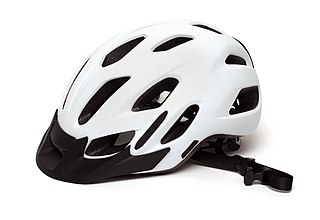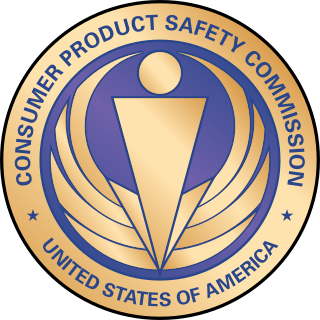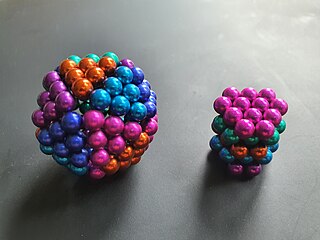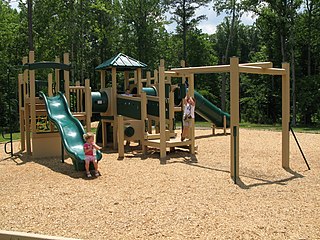
An all-terrain vehicle (ATV), also known as a light utility vehicle (LUV), a quad bike, or simply a quad, as defined by the American National Standards Institute (ANSI); is a vehicle that travels on low-pressure tires, with a seat that is straddled by the operator, along with handlebars for steering control. As the name implies, it is designed to handle a wider variety of terrain than most other vehicles. Although it is a street-legal vehicle in some countries, it is not street-legal within most states, territories and provinces of Australia, the United States or Canada.

ASTM International, formerly known as American Society for Testing and Materials, is an international standards organization that develops and publishes voluntary consensus technical standards for a wide range of materials, products, systems, and services. Some 12,575 ASTM voluntary consensus standards operate globally. The organization's headquarters is in West Conshohocken, Pennsylvania, about 5 mi (8.0 km) northwest of Philadelphia.

A bicycle helmet is a type of helmet designed to attenuate impacts to the head of a cyclist in falls while minimizing side effects such as interference with peripheral vision. There is ongoing scientific research into the degree of protection offered by bicycle helmets in the event of an accident, and the effects of helmet wearing on cyclist and motor vehicle driver behaviour.

The United States Consumer Product Safety Commission is an independent agency of the United States government. The CPSC seeks to promote the safety of consumer products by addressing “unreasonable risks” of injury ; developing uniform safety standards ; and conducting research into product-related illness and injury. In part due to its small size, the CPSC attempts to coordinate with outside parties—including companies and consumer advocates—to leverage resources and expertise to achieve outcomes that advance consumer safety. The agency was created in 1972 through the Consumer Product Safety Act. The agency reports to Congress and the President; it is not part of any other department or agency in the federal government. The CPSC has five commissioners, who are nominated by the president and confirmed by the Senate for staggered seven-year terms. Historically, the commission was often run by three commissioners or fewer. Since 2009, however, the agency has generally been led by five commissioners, one of whom serves as chairman. The commissioners set policy for the CPSC. The CPSC is headquartered in Bethesda, Maryland.

Inez Moore Tenenbaum is an American lawyer and politician who served as South Carolina Superintendent of Education and as Chair of the United States Consumer Product Safety Commission. In 2016 she joined a law firm. She is a member of the Democratic Party.

Toy safety is the practice of ensuring that toys, especially those made for children, are safe, usually through the application of set safety standards. In many countries, commercial toys must be able to pass safety tests in order to be sold. In the U.S., some toys must meet national standards, while other toys may not have to meet a defined safety standard. In countries where standards exist, they exist in order to prevent accidents, but there have still been some high-profile product recalls after such problems have occurred. The danger is often not due to faulty design; usage and chance both play a role in injury and death incidents as well.

An outdoor playset is a structure erected outside for children to play on and around.
First Alert is the retail brand of American safety equipment manufacturer BRK Brands, Inc., established in 1976 and based in Aurora, Illinois, with a production plant in Juarez, Mexico. Products sold with the brand include carbon monoxide detectors, smoke alarms, fire extinguishers, and other safety products like flashlights and fire escape ladders. First Alert supports fire safety in partnership with Safe Kids USA and The United States Fire Administration, providing smoke alarms at reduced cost to low-income families in the United States.

Kids in Danger (KID) is an American non-profit dedicated to educating parents, training engineers, designers, and manufacturers, and advocating for improvements in children's product safety in cribs, toys, bathtub seats, bunk beds, car seats, carriers, costumes, crib bumpers, high chairs, gates, play yards, strollers, walkers, and other potentially dangerous items. Its website supplies listings of products recalled by the Consumer Product Safety Commission and provides suggestions and information on how to protect children. KID also works alongside other groups such as the Consumer Federation of America and Consumer Reports in order to improve product safety.
Fire safe cigarettes, abbreviated "FSC", also known as lower ignition propensity (LIP), reduced fire risk (RFR), self-extinguishing, fire-safe or reduced ignition propensity (RIP) cigarettes, are cigarettes that are designed to extinguish more quickly than standard cigarettes if ignored, with the intention of preventing accidental fires. In the United States, "FSC" above the barcode signifies that the cigarettes sold are fire standards compliant (FSC).

Child-resistant packaging or CR packaging is special packaging used to reduce the risk of children ingesting hazardous materials. This is often accomplished by the use of a special safety cap. It is required by regulation for prescription drugs, over-the-counter medications, Nicotine Containing Electronic Cigarette devices or Refill containers that can contain Nicotine EUTPD 36.7 pesticides, and household chemicals. In some jurisdictions, unit packaging such as blister packs is also regulated for child safety.

The Consumer Product Safety Improvement Act (CPSIA) of 2008 is a United States law signed on August 14, 2008 by President George W. Bush. The legislative bill was known as HR 4040, sponsored by Congressman Bobby Rush (D-Ill.). On December 19, 2007, the U.S. House approved the bill 407-0. On March 6, 2008, the U.S. Senate approved the bill 79-13. The law—public law 110-314—increases the budget of the Consumer Product Safety Commission (CPSC), imposes new testing and documentation requirements, and sets new acceptable levels of several substances. It imposes new requirements on manufacturers of apparel, shoes, personal care products, accessories and jewelry, home furnishings, bedding, toys, electronics and video games, books, school supplies, educational materials and science kits. The Act also increases fines and specifies jail time for some violations.
The Virginia Graeme Baker Pool and Spa Safety Act (VGBA) is a United States law named after Virginia Graeme Baker, who died after sustaining a pool suction-drain injury in June 2002, when the suction from a spa drain entrapped her under the water. It is incorporated as Title 14 of the U.S. Energy Independence and Security Act of 2007. This act became enforceable law on December 19, 2008.
A playground surface is the material that lies under and around swings, slides, monkey bars and other playground equipment. The surfaces are usually made of wood or rubber and designed specifically for aesthetics, child safety, and/or ADA wheelchair accessibility. Playground safety surfacing often involves the use of recycled rubber tire products such as poured rubber, rubber tiles or loose rubber mulch.
Springfree Trampoline is a company that manufactures recreational trampoline products and accessories. The design was created by Dr. Keith Vivian Alexander, an associate professor in the Mechanical Engineering Department at the University of Canterbury in Christchurch, New Zealand.

A drawstring is a string, cord, lace, or rope used to "draw" fabric or other material. Ends of a drawstring are often terminated with a sheath called an aglet. The ends may be tied to hold the drawstring in place. Alternatively, it may be kept drawn using a cordlock. Typically, the drawstring is loose when not being used and tightened when needed during use.

Neodymium magnets, usually small spheres, have been manufactured as educational toys, stress relief products, and an artistic medium.
Pamela B. Gilbert is an American lawyer and has been a partner of the law firm Cuneo Gilbert & LaDuca, LLP since 2003, where she heads the firm's lobbying practice. Gilbert is a noted consumer rights advocate who has testified before Congress over fifty times and made dozens of appearances in the national print and electronic media. Gilbert leads the Committee to Support Antitrust laws (COSAL), an organization supportive of antitrust legislation.

A playground, playpark, or play area is a place designed to provide an environment for children that facilitates play, typically outdoors. While a playground is usually designed for children, some are designed for other age groups, or people with disabilities. A playground might exclude children below a certain age.

Laundry detergent pods are water-soluble pouches containing highly concentrated laundry detergent, softener and other laundry products. Notable brands of these packs include All, Arm & Hammer, Gain, Purex, Persil and Tide. They first became popular in February 2012 when they were introduced by Procter & Gamble as Tide Pods.













